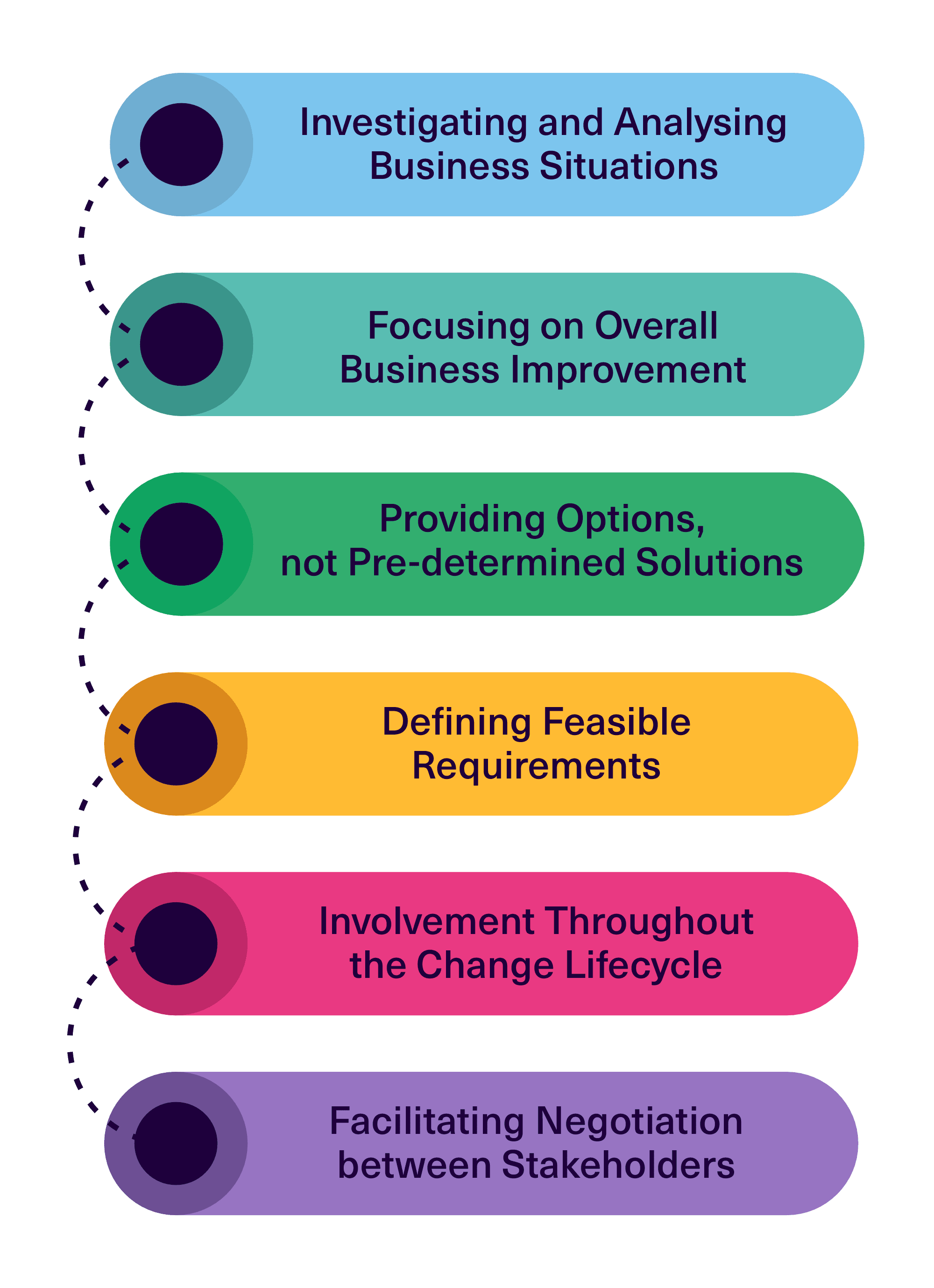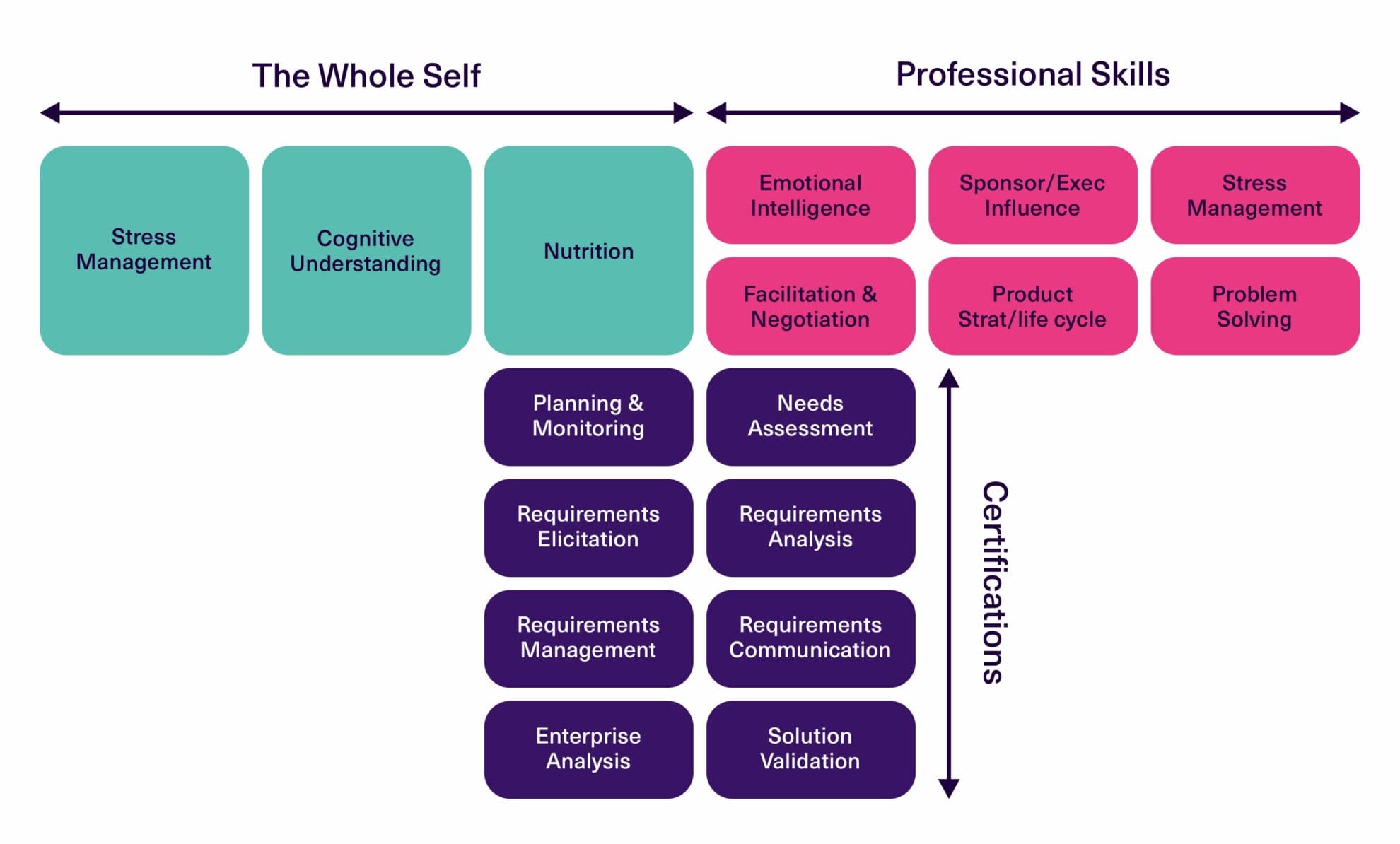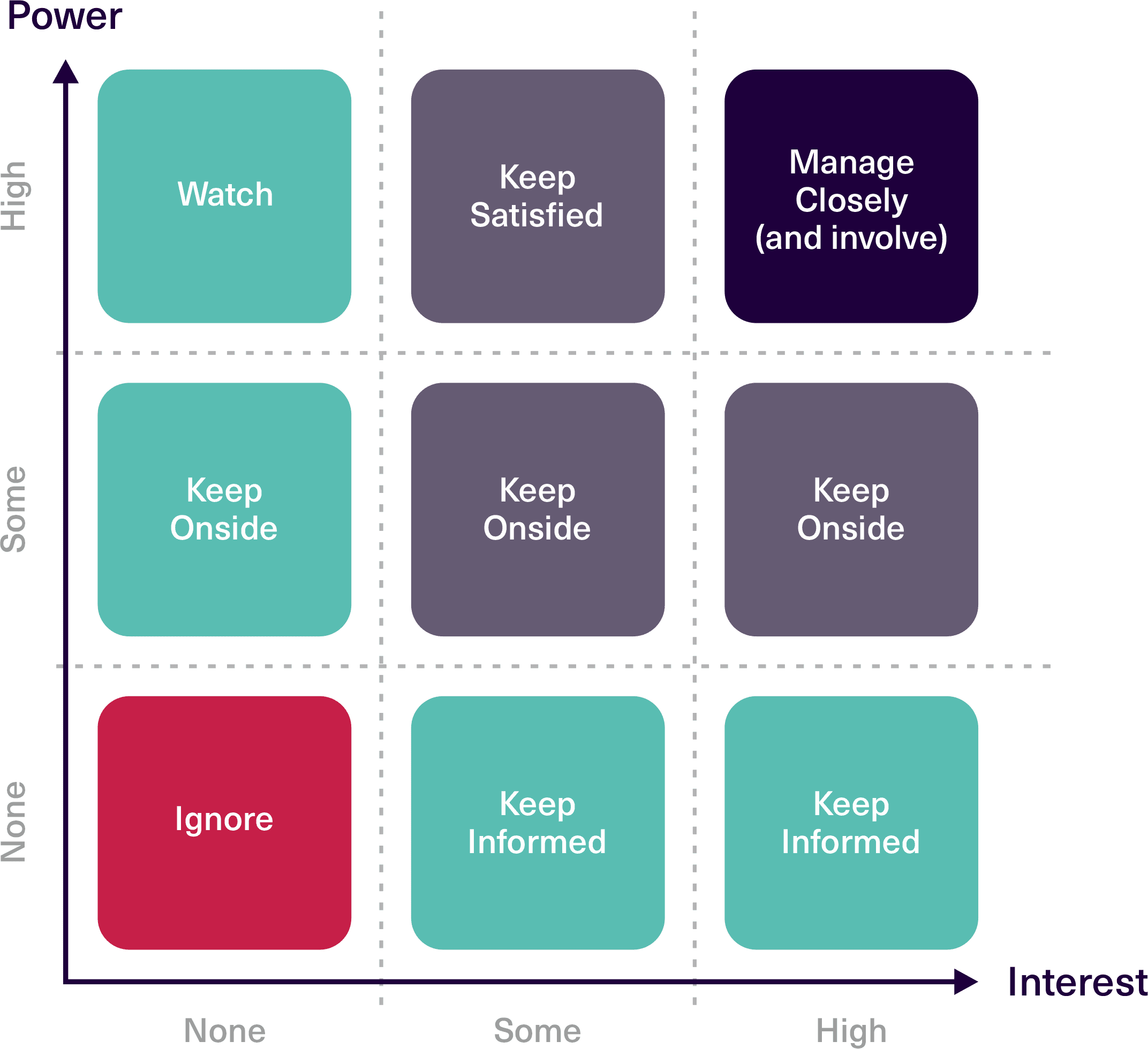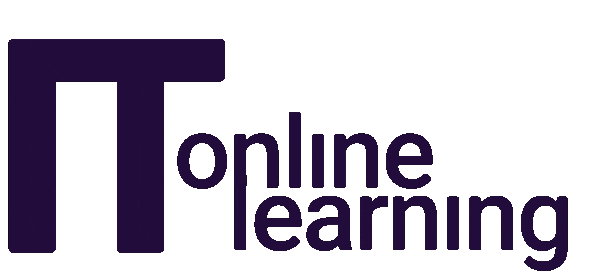Introduction
In an ultra-competitive business world, staying ahead isn’t just about having great products or services – it’s about adapting quickly and making smart, data-driven decisions. This is where business analysis comes in. Acting as a bridge between a company’s goals and the technology needed to achieve them, business analysts helps organisations find inefficiencies, streamline processes, and align their initiatives with strategic objectives. In this post, we’ll explore what business analysis really is, dive into the core responsibilities of a Business Analyst (BA) and look at why this role is so essential to modern business success.
What is Business Analysis?
At its core, business analysis is about problem-solving. But instead of focusing on surface-level symptoms, business analysts dig deep to uncover the root causes of issues that slow down a company’s growth. For example, imagine a company facing declining sales. While it might be easy to blame poor marketing, a Business Analyst would go deeper, uncovering hidden issues like outdated inventory software or broken internal processes that leave customers unsatisfied. By tackling the underlying problem, the Business Analyst ensures that the solution not only fixes the immediate issue but prevents it from happening again in the future.
Role and Responsibilities of a Business Analyst
1. Understanding the Root Cause of the Problem
A crucial responsibility of business analysts is identifying the underlying issues within an organisation. Take the example of declining sales. Rather than just focusing on surface-level problems like poor customer engagement, a skilled business analyst digs deeper into operational factors – such as outdated software – that could be hindering customer satisfaction and overall business performance.
2. Gathering and Documenting Stakeholder Requirements
Another core responsibility is gathering and accurately documenting stakeholder requirements. In an e-commerce scenario, for example, a business analyst may be tasked with defining the need for a recommendation engine that enhances the customer shopping experience by suggesting related products, thus driving more sales and improving user satisfaction.
3. Process Improvement at the Heart of Business Analysis
Business analysts play a vital role in improving existing processes. Consider a financial services company facing a slow loan approval process. By identifying inefficiencies, a business analyst can introduce automation for manual tasks, dramatically speeding up approval times and boosting operational efficiency.
4. Evaluating Solution Feasibility
One of the most important responsibilities is evaluating the feasibility of proposed solutions. Should a company completely overhaul its HR system, or would integrating a modern cloud platform be a more cost-effective option? Business analysts use data-driven insights to recommend the most suitable approach, balancing cost, time, and strategic fit.
5. Ensuring Success Through User Acceptance Testing (UAT)
Business analysts are instrumental during user acceptance testing (UAT). Before a system like a CRM goes live, a business analyst ensures that critical functions – such as lead tracking and reporting – work seamlessly, ensuring the system meets the business’s needs and goals.
6. Acting as a Bridge Between Business and Technical Teams
Business analysts often act as mediators between business and technical teams, ensuring clear communication and mutual understanding. By fostering collaboration, they help prevent costly miscommunications and keep both sides aligned toward the same objectives.
7. Aligning Changes with Business Strategy
Finally, business analysts ensure that all changes align with the broader business strategy. For example, if a retail chain aims to increase online sales by 30% over the next two years, the business analyst will ensure that new systems and marketing tools directly support this strategic goal.

As we can see, Business Analysts play a crucial role in ensuring that business problems are not only identified but also well-documented and addressed with solutions that are both feasible and strategically aligned with the organisation’s goals. They act as problem solvers, communicators, and technical experts, working across multiple layers of a business to improve processes, implement solutions, and help companies meet their objectives.
Business Analysis in Action
Business analysis goes beyond simply gathering data – it’s about driving meaningful improvements that make a lasting impact. Whether a Business Analyst is identifying inefficiencies, optimising workflows, or aligning stakeholders, they are involved at every step of a project’s lifecycle. Their focus is always on delivering solutions that are not only effective but sustainable and aligned with broader business goals.
For instance, when a company is preparing to roll out a new Customer Relationship Management (CRM) system, a Business Analyst collaborates with both technical teams and sales departments to ensure that the lead tracking functionality fits the business’s unique needs. This hands-on approach ensures that the new system doesn’t just function properly, but also aligns with long-term objectives like improving customer retention and boosting sales.
Key Aspects of Business Analysis
Business analysis isn’t about quick fixes or surface-level adjustments. It’s about creating long-term, sustainable solutions that drive organisational change. Here are some of the key aspects of the discipline:
- Getting to the Root of the Problem: Business Analysts dig deep to identify the true causes of issues, rather than just addressing symptoms. This approach ensures that the solutions they propose are effective and built to last.
- Focusing Beyond IT Systems: While technology plays a role, Business Analysts focus on improving overall business processes, ensuring that any changes are aligned with the company’s broader strategy.
- Offering Flexible Solutions: Instead of prescribing a one-size-fits-all solution, Business Analysts present multiple options, allowing organisations to choose the path that best fits their goals, resources, and constraints.
- Defining Practical and Strategic Requirements: BAs don’t try to meet every request that comes their way. They focus on defining realistic requirements that directly contribute to business goals, avoiding unnecessary complexity.
- Engagement Throughout the Project Lifecycle: A Business Analyst’s job doesn’t stop after gathering requirements. They stay involved through the entire lifecycle—from investigation and design to implementation and realisation—ensuring the project’s success.
- Managing Stakeholder Conflicts: Disagreements among stakeholders are common in any change initiative. Business Analysts play a key role in managing these conflicts, facilitating negotiations, and ensuring the best outcome for the business.

Key Skills of a Business Analyst
To excel in their role, Business Analysts must bring a wide range of skills to the table. From critical thinking and problem-solving to managing stakeholder relationships, the success of a Business Analyst hinges on their ability to bridge the gap between business and technical teams. Clear communication is especially crucial, as a Business Analyst must gather requirements from stakeholders and translate complex technical solutions into language that non-technical stakeholders can easily understand. For example, when a company aims to increase sales by 30%, the Business Analyst ensures that any new digital marketing tools are aligned with this strategic goal and tailored to meet the business’s unique needs.
A successful Business Analyst typically needs to develop expertise across three key skill areas:
- Communication, Critical Thinking, and Problem-Solving
Strong communication, critical thinking, and relationship-building skills are essential for engaging with stakeholders and understanding the business’s core needs. These skills enable Business Analysts to ask the right questions, foster collaboration, and offer actionable insights. - Commercial Awareness and Industry Knowledge
Commercial awareness and financial acumen, combined with an understanding of industry-specific processes, allow Business Analysts to tailor solutions that address the unique challenges of their organisation. Their ability to see the bigger picture ensures that recommendations make sense from both a business and industry perspective. - Technical Skills and Stakeholder Management
Technical skills such as business process modelling, stakeholder management, and requirements engineering are key to eliciting, documenting, and validating business needs. These skills ensure that all stakeholders are aligned, and that the proposed solutions are feasible and meet the project’s objectives.

Today’s Business Analysts are expected to do more than ever. Along with core analytical and problem-solving abilities, they need digital skills and the ability to analyse data effectively. As emerging technologies like AI, robotics, and automation become central to business operations, Business Analysts must understand how these technologies can drive change.
To succeed, Business Analysts should aim to have a “T-shaped” skill set – deep ability in their specialist area (the vertical bar of the T) and a broad knowledge base across other disciplines (the horizontal bar of the T). This combination of in-depth and cross-functional skills allows them to approach business challenges holistically. Additionally, ongoing professional development is essential as the business and technology landscape continues to evolve rapidly.
The Business Analysis Process
The business analysis process is iterative and highly adaptable, allowing Business Analysts to tailor their approach based on the unique context of each project.
Here are the key stages of this process:
- Investigating the Current State
Business Analysts begin by examining the existing processes and finding the root causes of any problems. - Evaluating Possible Solutions
Once the issues are clear, they evaluate potential solutions by considering factors like costs, benefits, and risks. - Redesigning Business Processes
To improve outcomes, they redesign processes to be more efficient and aligned with business goals. - Gathering and Documenting Requirements
Business and technical requirements are gathered and documented to ensure a clear understanding of what’s needed for the solution. - Collaborating with Developers
Business Analysts work closely with development teams to ensure that the requirements are understood and properly implemented. - Testing and User Acceptance
They ensure that solutions meet business needs by conducting user testing and ensuring the system functions as expected. - Supporting Implementation and Adoption
A crucial part of the process is supporting the implementation of new solutions and helping teams adopt them smoothly. - Monitoring and Measuring Success
Finally, Business Analysts track the success of the changes, ensuring they deliver the expected benefits and adjusting where necessary.
It’s important to note that this process isn’t always linear. Depending on whether the project follows a predictive (waterfall) or adaptive (agile) approach, the stages may overlap or evolve as the project progresses.

Types of Requirements
When planning and executing a project, it’s essential to find and define different types of requirements. These requirements form the foundation for achieving project objectives and guide how various aspects of the solution should be implemented. Let’s break down the various categories of requirements:
1. Business Requirements
Business requirements outline the high-level goals the organisation or project aims to achieve. These strategic goals focus on what the organisation wants to accomplish without detailing how it will be done. For instance, a business requirement might be to increase online sales by 20% over the next year, reflecting a measurable outcome that aligns with the company’s overall goals.
2. Functional Requirements
Functional requirements specify what the system or solution must do to meet business objectives and stakeholder needs. These requirements describe the system’s features and behaviours. For example, the system must allow users to log in via email or social media accounts, ensuring that the login process is flexible and supports user convenience.
3. Non-Functional Requirements
Non-functional requirements define the quality attributes, constraints, and conditions under which the system must operate. They focus on aspects like performance, security, and usability. For example, the system must load pages within 2 seconds, or it must comply with GDPR regulations. These requirements ensure that the system performs well while adhering to legal and performance standards.
4. Technical Requirements
Technical requirements detail the system’s technical specifications, such as infrastructure, platforms, or frameworks. For instance, a technical requirement could be that the system must be built using microservices architecture and hosted on AWS. These requirements provide the technical foundation for development decisions.
5. Regulatory or Compliance Requirements
Regulatory or compliance requirements ensure the solution meets all legal and industry standards. These are crucial for mitigating legal risks and maintaining ethical standards. For example, ensuring compliance with PCI-DSS for payment transactions guarantees that sensitive financial data is handled securely and in accordance with legal obligations.
By clearly defining and categorising these requirements, organisations can ensure that their projects not only meet business goals but also comply with technical, legal, and user expectations. Each type of requirement plays a distinct role in guiding project development, ensuring the final product is both functional and aligned with organisational objectives.
Stakeholder Analysis
Identifying and managing stakeholders is one of the most crucial responsibilities of a business analyst. It ensures that all parties involved in a project are aligned, engaged, and supportive of the changes being made. Poor stakeholder management is often cited as a primary reason projects fail or underperform. Let’s explore how effective stakeholder identification and management can drive successful business change initiatives.
1. Importance of Stakeholder Identification and Management
Effective stakeholder management is essential for project success. Poor stakeholder engagement often leads to confusion, resistance, or errors in the final solution. For example, in a project to overhaul a company’s financial systems, not engaging key finance department stakeholders could result in resistance or mistakes. Conversely, engaging them early ensures their concerns are addressed, fostering ownership and commitment to the project’s success.
2. Building Relationships and Mitigating Risks
Building strong relationships with stakeholders helps secure their support for the project. By engaging key players, business analysts ensure they understand why changes are necessary and how they help the organisation. Additionally, identifying stakeholders who may oppose the changes early on helps mitigate potential risks by addressing concerns before they become obstacles.
3. Stakeholder Identification Process
The first step in stakeholder management is identifying who the stakeholders are. Stakeholders can be anyone affected by the project or with an interest in its outcome. Business analysts often use tools like the Stakeholder Wheel to ensure all relevant voices – from internal teams to external customers – are included in the decision-making process. Workshops with knowledgeable team members also help ensure no critical stakeholders are overlooked.
4. Stakeholder Analysis
Once stakeholders are identified, the next step is analysing their influence and interest in the project. Tools like the Power/Interest Grid categorise stakeholders based on their influence and interest, allowing for tailored management strategies. For example, a marketing department may have low interest but high power in a project involving new customer service software. In such cases, it’s essential to keep them satisfied without overwhelming them with unnecessary details.
5. Stakeholder Management Strategies
Different stakeholders need various levels of engagement based on their influence and interest. Key stakeholders with high influence and interest need continuous, active management. For instance, the head of sales in a new e-commerce platform development project would require regular involvement and updates. On the other hand, stakeholders with lower influence but high interest, such as an enthusiastic IT support team, may not need to be deeply involved but can offer valuable practical insights.
By effectively managing stakeholders through identification, analysis, and engagement strategies, business analysts can drive projects toward successful outcomes, ensuring all parties are aligned and working towards the same goals.

6. Addressing Stakeholder Needs Throughout the Project Lifecycle
Stakeholder management is an ongoing process that spans the entire project lifecycle. Key activities include maintaining regular communication to keep stakeholders informed about progress and any changes, involving them in decision-making when appropriate, and setting clear expectations about the project’s scope and outcomes. Addressing conflicts between stakeholders’ expectations and project goals early on helps prevent escalation. Additionally, consistently seeking stakeholder feedback and incorporating it into the project can greatly enhance its success. For instance, during the development of a new HR management system, ongoing feedback from the HR team ensures that the system’s functionality meets their day-to-day requirements.
7. Clarifying Stakeholder Responsibilities
Assigning clear roles and responsibilities is essential for managing stakeholder expectations. Tools like the RACI (Responsible, Accountable, Consulted, Informed) Chart are commonly used to define who handles specific tasks and who needs to be consulted. This helps prevent confusion and ensures that everyone understands their role in the project, improving accountability and collaboration.
8. Understanding Stakeholder Perspectives
Tools such as CATWOE and Business Activity Models (BAM) are valuable for analysing stakeholder perspectives, values, and potential conflicts. By understanding different viewpoints, business analysts can predict issues and build consensus, ensuring smoother project execution. For example, during a major system upgrade, a business analyst might use CATWOE to assess how the changes will affect various departments, ensuring that all perspectives are considered before making critical decisions.
Stakeholder analysis is a crucial, ongoing process in business analysis that ensures project success through building support, mitigating risks, and fostering clear communication. By identifying the right stakeholders, understanding their needs, and keeping them engaged, business analysts can drive successful business change that aligns with organisational goals. Effective stakeholder management can be the difference between a project that falters and one that thrives.
Why Exams Matter for Business Analysts
While practical experience is vital, formal certifications like the BCS (British Computer Society) Business Analysis exams and PRINCE2 certifications provide a structured understanding of essential methodologies, tools, and techniques. These certifications confirm your knowledge and skills, ensuring you are prepared to handle real-world business challenges.
- BCS Business Analysis Foundation Exam: This certification provides a solid introduction to business analysis principles, equipping aspiring business analysts with the skills to investigate problems, gather requirements, and recommend workable solutions.

- PRINCE2 Certification: For BAs working in project management environments, PRINCE2 offers a framework to manage projects efficiently. It ensures that all projects align with business goals, are delivered on time, and stay within budget.

Why Integrating Exams Makes a Difference
Earning certifications offers business analysts more than just credibility – it directly improves career prospects. In fast-evolving industries, staying current with best practices through certifications is essential. The knowledge gained from these exams can be immediately applied to day-to-day business analysis tasks, enhancing performance, decision-making, and overall effectiveness on the job. Certifications show a commitment to professional growth and confirm your ability in tackling real-world challenges.
The Future of Business Analysis
As businesses continue to evolve, the role of business analysts is becoming increasingly strategic. No longer confined to IT projects, they are now integral to driving broader organisational change. Whether it’s process improvement or leading digital transformation initiatives, business analysts help guide companies through today’s complex business landscape.
Whether you’re just starting your journey or looking to advance your career, business analysis offers a wide array of opportunities. By mastering core principles, earning certifications, and continuously refining your skills, you can position yourself as a valuable asset to any organisation.
Conclusion
Business analysis isn’t just about solving immediate challenges – it’s about enabling sustainable growth and ensuring long-term success through informed, strategic decision-making. As the business environment grows more complex, the demand for skilled business analysts continues to rise. These professionals play a vital role in aligning organisational goals with business changes, ensuring companies stay adaptable, innovative, and successful in today’s dynamic landscape.
By investigating problems, optimising processes, and implementing well-aligned solutions, business analysts drive sustainable change. Their unique ability to bridge the gap between business needs and technological advancements makes them indispensable to organisations aiming for long-term success.




